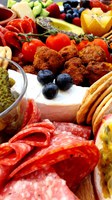Prairie Fare: 7 steps to making your own charcuterie board
(Click an image below to view a high-resolution image that can be downloaded)
When I was young, my mother would have coffee parties now and then. All the neighborhood ladies came over for open-faced cheese and meat sandwiches, peach upside down cake (or something similar), nuts, mints and coffee. The food was served on glass trays with cups that fit into an indentation on the tray.
While my mother did her last-minute preparation, I would entertain the ladies by showing them a doll or some pictures I had drawn. I was too young to attend school at this point.
I recall my mother’s wide eyes when she returned to the room after clearing their trays and cups. I was wiping everyone’s face with a dish cloth.
They were laughing, and my mom was quite embarrassed. I was just cleaning their faces after they ate, like a mom would. I was not a food safety specialist back then.
I still have some of those glass trays and cups, which are now considered vintage, or maybe even “antique.”
Coffee parties were probably the Midwestern answer to “tea parties” that have gone on for centuries. Besides coffee parties and potlucks, many other serving trends have been popular through the years.
In the 1960s and again more recently, fondue parties have been a trend. Fondue has its historical roots in the 1800s, most likely in Switzerland. Melted cheese mixed with wine, flour and herbs and served with bread sustained some of the less-wealthy people without easy access to fresh food.
Fondue pots were frequent wedding gifts years ago, and you can find vintage fondue pots in thrift stores and garage sales. Fondue often consisted of a melted cheese sauce into which you dip bread, vegetables, fruit, meat or other foods as you sat around a table and visited. Sometimes, small pieces of marinated meat are cooked on skewers in a pot of hot oil.
More recently, chocolate fountains have become a trend at celebrations such as weddings and other parties. You can dip fruit or pieces of cake into a flowing fountain of chocolate.
Of all the trends, “charcuterie” (pronounced “shar-koo-tree”) boards have caught my eye in recent years. This is another example of an old way of serving that has been adapted for modern times.
According to some sources, the word charcuterie first appeared in print in 1825. In French, the word meant “pork butcher’s shop.” In present times charcuterie often includes cured meat products such as salami, ham or summer sausage. These meat products were developed long ago out of necessity. Years ago, a way to refrigerate foods was not available in every home.
Charcuterie boards (or plates or platters) usually consist of proteins, cheese, nuts, fruits, vegetables, crackers or other grain artfully arranged. For example, often the meat slices are shaped into roses or other shapes.
These charcuterie boards are similar to meat and cheese trays but make a “full meal” with all the food groups on deck. If you’d like to create a fancy charcuterie board for a party, be mindful to provide options for people who may have allergies to wheat, milk or other foods. You might need to make a separate allergen-free board for guests with special dietary needs.
Here are seven steps to create a charcuterie board. Images of charcuterie are readily available online if you need artistic inspiration.
- Select a board and a few small bowls. A tray, plate, cutting board or baking sheet will work as a board for your creation. Make sure the board is sturdy and the size is sufficient to hold enough food for the number of guests. You may want to make more than one board to accommodate many people. Multiple, smaller boards may be easier to keep and store in the refrigerator than one large board. Bowls can hold small food items and dips or spreads.
- Choose meats or other protein sources such as hard-cooked egg slices or deviled eggs. Fold or stack sliced or cubed meat to add eye-pleasing variety to the board. Sliced meats can be folded into halves or triangles and arranged like books on a shelf to create a ribbon-like illusion. Options could also include chunks of roasted or grilled chicken, turkey, ham, chorizo, pepperoni, prosciutto or salami.
- Pick out crackers or bread. Try whole grain or multigrain crackers, sliced baguettes, pita bread, naan bites or pretzels.
- Select cheeses. Try including a mixture of soft, semi-hard and hard cheeses for texture variation. Soft variations include feta, brie and ricotta. Semi-hard variations include gouda and jack. Hard variations include cheddar and parmesan.
- Add color. Arrange fruits and vegetables on the board to add a pop of color and a variety of important nutrients, including fiber and vitamins A and C. Cut fruits and vegetables into unconventional shapes to add eye-catching elements.
Fruits could include grapes, berries, cantaloupe, honeydew, oranges or dried fruit. Avoid including fruits that brown when sliced, such as apples and bananas. Vegetables could include bell pepper strips, broccoli florets, carrot sticks, snap peas, cucumber slices or celery sticks. - Include a dip or spread. Fill small bowls with dips, spreads, sauces or jelly. Options could include hummus (chickpea dip), jelly or jam, honey, flavored yogurt, salsa, mustards, or sour cream or cream cheese-based dip.
- Fill in with extras. Add assorted food items such as nuts, seeds, pickled vegetables, granola or other sweet treats in small bowls.
(Julie Garden-Robinson, Ph.D., R.D., L.R.D., is a North Dakota State University Extension food and nutrition specialist and professor in the Department of Health, Nutrition and Exercise Sciences. Follow her on Twitter @jgardenrobinson)
NDSU Agriculture Communication – June 8, 2023
Source: Julie Garden-Robinson, 701-231-7187, julie.garden-robinson@ndsu.edu
Editor: Elizabeth Cronin, 701-231-7881, elizabeth.cronin@ndsu.edu




